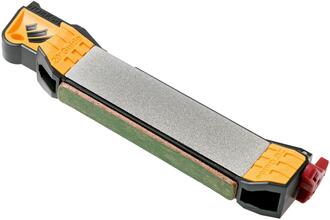How to sharpen a knife?
The basis is to have a good, sharp knife. With a sharp knife, every cut is easier, faster and, above all, safer. In this article you will find all the basic information on how you too can sharpen your knife professionally.
When should a knife be sharpened?
The first thing you need to do is carefully examine the blade of the knife, it will help you decide how much the knife needs to be sharpened.
How to test the blade?
- Lightly place the blade on your thumb nail and slide it away from you. If the blade slides over the nail without catching, its edge will most likely be blunt.
- For the second test you will need a piece of paper. Hold it in front of you and cut downwards away from your hand with the blade. If you do not cut the paper under the pressure of the knife, again the problem is that the blade of the knife is not sharpened enough. More in the article how to test the sharpness of a knife.< /strong>
- It is most advantageous to test the knife cut on materials such as vegetables, rope or cardboard. If you have to use a lot of force when cutting, or if you have to "saw", this again means - a poorly sharpened blade.
Blade angle
The angle of the blade will vary depending on the style and use of the knife. These angles usually range from 10-35 degrees. A 10-degree angle is a very fine edge (imagine a razor). A much larger angle, such as 35 degrees, is found on a thick blade such as a machete. The larger the angle, the more durable the edge, which means it can withstand even harder cutting material. The smaller the angle, the more refined and precise the cut will be. Both blade angles will stay sharp longer when used for proper cutting purposes.
When deciding what angle you want on your knife, just look at the manufacturer's recommendation. The degrees may vary slightly and you can easily adjust the angle of the blade with Work Sharp products such as KEN ONION EDITION KNIFE & TOOL SHARPENER, which is set in steps of 1 degree.
The rule you must follow is:
- 17 - 20 degrees for kitchen knives
- 22 - 35 degrees for outdoor knives
- 30-40 degrees for outdoor tools
Steel and knives
Steels differ from each other. They can be soft, hard or brittle. Understanding steel will help you sharpen. See this article - https://www.knifestock.sk/ noziarske-ocele-a35, which contains a clear list of steel types and information that is useful for sharpening them.
Blade shape
Based on the shape of the blade, the method of sharpening changes. If you have a typical straight edge, you will follow the curve of the blade when sharpening. A blade like the "tanto" may seem like a challenge to sharpen, but it's actually very easy! Sharpen the longer edge up to the first point and then maneuver the blade so that only the shorter top edge is sharpened, the other ending again at the point where the two edges intersect. With a serrated edge, you only sharpen the flat side without the bevel. If you have small ceramic sharpening stones, for example WORK SHARP GUIDED FIELD SHARPENER, or COMBO KNIFE SHARPENER you can easily sharpen even between the notches of the serrated blade.
Which abrasives should you use?
Assess the condition of your knife. Use a coarse abrasive if the edge is inconsistent or there are chips on the blade. We recommend that you use: ORIGINAL KNIFE & TOOL SHARPENER. Another reason to use a coarser abrasive is if you are sharpening harder steel. In that case, when the edge is sharp, use medium or fine sandpaper to fine-tune it.
Sign up for news
Did this article interest you? Join the other happy subscribers of the newsletter using the form below and be the first to know about news, promotions or exclusives!




























































































































































 Slovakia
Slovakia  Czech Republic
Czech Republic  Austria
Austria  Germany
Germany  Hungary
Hungary  Romania
Romania  Poland
Poland